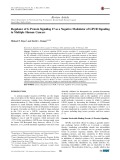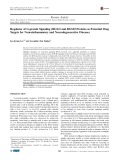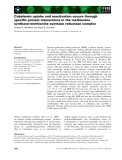
RGS protein
-
Regulators of G protein signaling (RGS) proteins modulate G protein-coupled receptor (GPCR) signaling networks by terminating signals produced by active Gα subunits. RGS17, a member of the RZ subfamily of RGS proteins, is typically only expressed in appreciable amounts in the human central nervous system, but previous works have shown that RGS17 expression is selectively upregulated in a number of malignancies, including lung, breast, prostate, and hepatocellular carcinoma.
 10p
10p  caothientrangnguyen
caothientrangnguyen
 09-05-2020
09-05-2020
 13
13
 1
1
 Download
Download
-
Regulator of G-protein signaling (RGS) proteins were originally identified as negative regulators of G-protein-coupled receptor (GPCR) signaling via their GTPase-accelerating protein (GAP) activity. All RGS proteins contain evolutionarily conserved RGS domain; however, they differ in their size and regulatory domains. RGS1 and RGS10 are smaller than other RGS proteins, and their functions involve various inflammatory responses including autoimmune responses in both the periphery and the central nervous system (CNS). Neuroinflammation is the chronic inflammatory response in the CNS.
 5p
5p  caothientrangnguyen
caothientrangnguyen
 09-05-2020
09-05-2020
 30
30
 2
2
 Download
Download
-
Regulator of G protein signaling (RGS) proteins are gatekeepers regulating the cellular responses induced by G protein-coupled receptor (GPCR)-mediated activation of heterotrimeric G proteins. Specifically, RGS proteins determine the magnitude and duration of GPCR signaling by acting as a GTPase-activating protein for Gα subunits, an activity facilitated by their semiconserved RGS domain. The R7 subfamily of RGS proteins is distinguished by two unique domains, DEP/DHEX and GGL, which mediate membrane targeting and stability of these proteins.
 13p
13p  caothientrangnguyen
caothientrangnguyen
 09-05-2020
09-05-2020
 30
30
 1
1
 Download
Download
-
Regulator of G protein signaling (RGS) proteins act as GTPase-activating proteins (GAPs) for Gasubunits and negatively regulate G protein-coupled receptor signaling. Using RGS5 gene-specific RT-PCR, we have identified a novel alternative splicing variant of RGS5 mRNA in human ocular tissues. The alternative splicing of RGS5 mRNA occurred at position +44 (GenBank NM_003617), spliced out 174 bp (+44 to +218 bp) of the cod-ing region, and encoded an RGS5s protein with a 108 amino acid N-ter-minal deletion. ...
 0p
0p  awards
awards
 05-04-2013
05-04-2013
 37
37
 2
2
 Download
Download
-
Human methionine synthase reductase (MSR), a diflavin enzyme, restores the activity of human methionine synthase through reductive methylation of methionine synthase (MS)-bound cob(II)alamin. Recently, it was also reported that MSR enhances uptake of cobalamin by apo-MS, a role asso-ciated with the MSR-catalysed reduction of exogenous aquacob(III)alamin to cob(II)alamin [Yamada K, Gravel RA, TorayaT & Matthews RG (2006) Proc Natl Acad Sci USA103, 9476–9481]. Here, we report the expression and purification of human methionine synthase from Pichia pastoris. ...
 10p
10p  viettel02
viettel02
 22-02-2013
22-02-2013
 51
51
 3
3
 Download
Download
CHỦ ĐỀ BẠN MUỐN TÌM

















